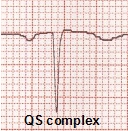CHAPTER 3 : Basic waves part 2
Page 1 of 1
 CHAPTER 3 : Basic waves part 2
CHAPTER 3 : Basic waves part 2
P WAVE
The P wave, which represents atrial depolarization, is a small positive (or negative) deflection before the QRS complex.
PR INTERVAL
The PR interval is measured from the beginning of the P wave to the beginning of the QRS complex. In adults the normal PR interval is between 0.12 and 0.2 second (three to five small box sides)
QRS NOMENCLATURE
One of the most confusing aspects of electrocardiography . The QRS complex represents the spread of a stimulus through the ventricles. However, not every QRS complex contains a Q wave, an R wave, and an S wave--hence the confusion. The bothersome but unavoidable nomenclature becomes understandable if you remember several basic features of the QRS complex . When the initial deflection of the QRS complex is negative (below the baseline), it is called a Q wave. The first positive deflection in the QRS complex is called an R wave. A negative deflection following the R wave is called an S wave.

In contrast, the following complex does not contain three waves:
If, the entire QRS complex is positive, it is simply called an R wave. However, if
the entire complex is negative, it is termed a QS wave (not just a Q wave as you might expect).

Occasionally the QRS complex contains more than two or three deflections. In such cases the extra waves are called R
(R prime) waves if they are positive and S
(S prime) waves if they are negative.
And capital letters (QRS) are used to designate waves of relatively large amplitude and small letters (qrs) label relatively small waves .

The QRS nomenclature is confusing at first, but it allows you to describe any QRS complex over the phone and to evoke in the mind of the trained listener an exact mental picture of the complex named. For example, in describing an ECG you might say that lead V1 showed an rS complex ("small r, capital S"):

You might also describe a QS ("capital Q, capital S") in lead aVf :

so always make it an habit even while discussing with frnds with capital and small !!!!
SEE U SOON IN THE NEXT CHAPTER WITH REST OF THE WAVES!!
The P wave, which represents atrial depolarization, is a small positive (or negative) deflection before the QRS complex.
PR INTERVAL
The PR interval is measured from the beginning of the P wave to the beginning of the QRS complex. In adults the normal PR interval is between 0.12 and 0.2 second (three to five small box sides)
QRS NOMENCLATURE
One of the most confusing aspects of electrocardiography . The QRS complex represents the spread of a stimulus through the ventricles. However, not every QRS complex contains a Q wave, an R wave, and an S wave--hence the confusion. The bothersome but unavoidable nomenclature becomes understandable if you remember several basic features of the QRS complex . When the initial deflection of the QRS complex is negative (below the baseline), it is called a Q wave. The first positive deflection in the QRS complex is called an R wave. A negative deflection following the R wave is called an S wave.

In contrast, the following complex does not contain three waves:
If, the entire QRS complex is positive, it is simply called an R wave. However, if
the entire complex is negative, it is termed a QS wave (not just a Q wave as you might expect).

Occasionally the QRS complex contains more than two or three deflections. In such cases the extra waves are called R
(R prime) waves if they are positive and S
(S prime) waves if they are negative.
And capital letters (QRS) are used to designate waves of relatively large amplitude and small letters (qrs) label relatively small waves .

The QRS nomenclature is confusing at first, but it allows you to describe any QRS complex over the phone and to evoke in the mind of the trained listener an exact mental picture of the complex named. For example, in describing an ECG you might say that lead V1 showed an rS complex ("small r, capital S"):

You might also describe a QS ("capital Q, capital S") in lead aVf :

so always make it an habit even while discussing with frnds with capital and small !!!!
SEE U SOON IN THE NEXT CHAPTER WITH REST OF THE WAVES!!

Admin- Admin
- Posts : 76
Reputation : 8
Join date : 2010-01-06
Age : 34
Location : chennai
 Similar topics
Similar topics» CHAPTER 2 : Basic waves
» CHAPTER 4 : BASIC WAVES , HEART RATE
» CHAPTER 7 : NORMAL WAVES "P"
» urban basic service prog
» CHAPTER 5 : ECG LEADS
» CHAPTER 4 : BASIC WAVES , HEART RATE
» CHAPTER 7 : NORMAL WAVES "P"
» urban basic service prog
» CHAPTER 5 : ECG LEADS
Page 1 of 1
Permissions in this forum:
You cannot reply to topics in this forum